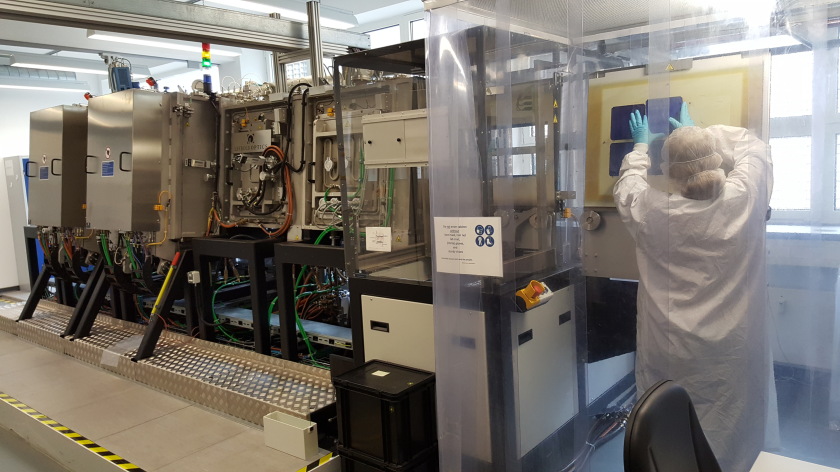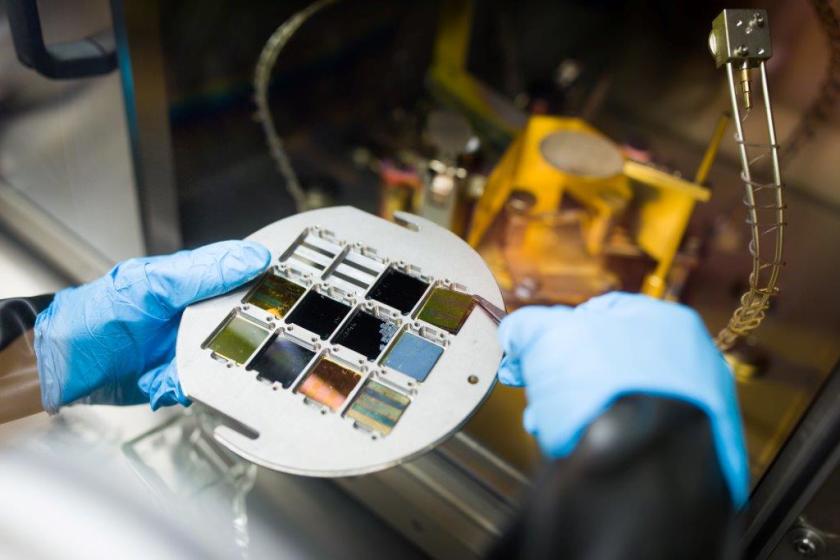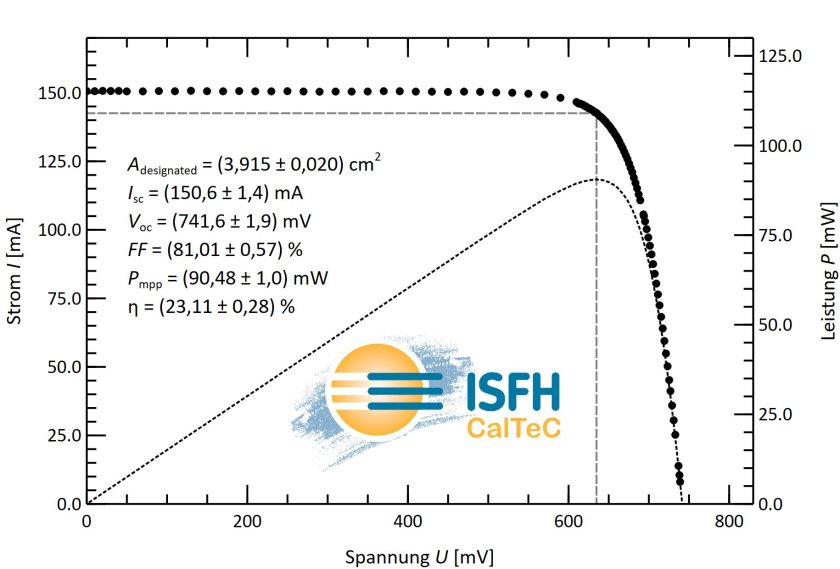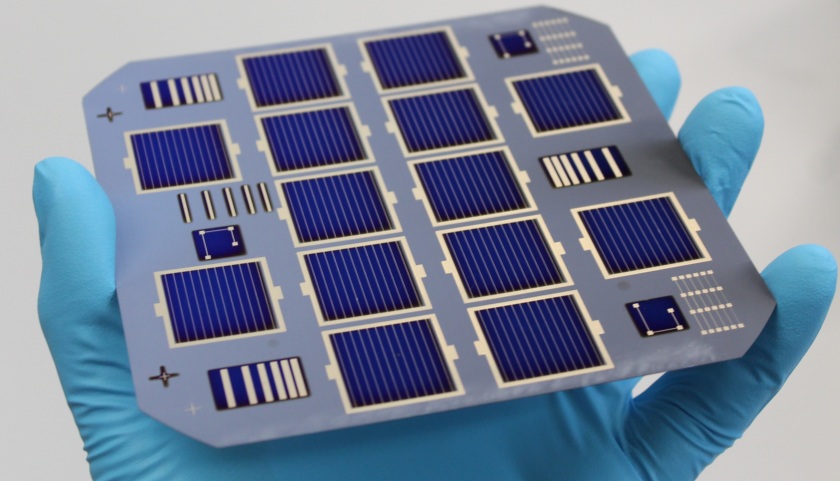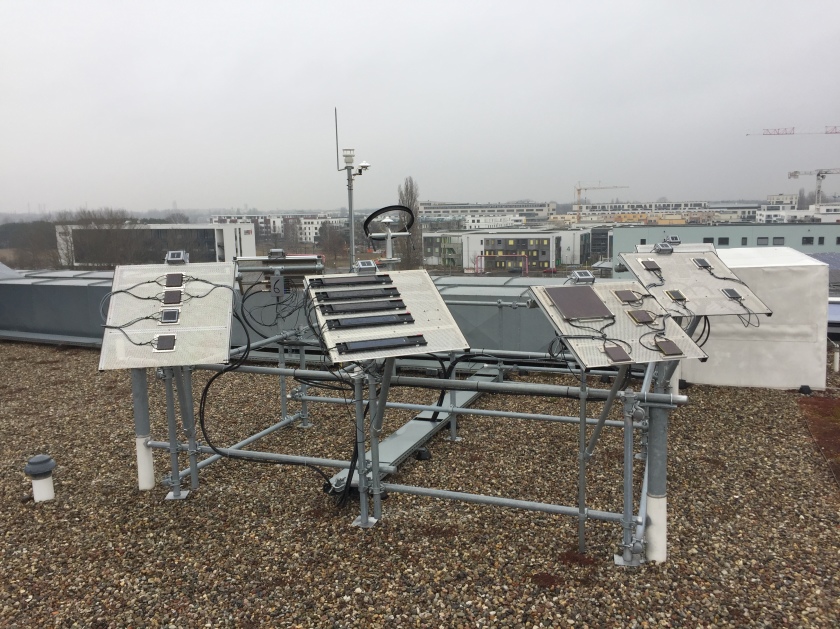PVcomB
News
2.8 Mio Euro Funding for preparing perovskite solar cells for high volume manufacturing
HZB participates in a new consortium for Perovskite solar technology that is led by Oxford PV Germany GmbH. The consortium is funded by the German Ministry of Economics and Energy with 2.8 Million Euros and aims to further demonstrate the manufacturability of perovskite-silicon tandem solar cells. (24.08.2018)
Further partners are Von Ardenne GmbH, Fraunhofer-Institute for Solar Energy Systems ISE, and the Technical University of Berlin. The project will focus on preparing perovskite solar cell technology for high volume manufacturing. This will include the optimisation of the perovskite-silicon tandem solar cell architecture, to make further efficiency improvements on industrial 156 mm x 156 mm wafer formats; the refinement of industrial scale process technology; and life-cycle analysis to inform the social-environmental impact of the tandem solar cells.
"Perovskite-based tandem solar cells are very promising to achieve really high efficiencies. In order to contribute to this exciting development we have built up strong competences in perovskites and tandem cell technology such as the Helmholtz Innovation Lab HySPRINT", says Prof. Dr. Rutger Schlatmann, Director of the Competence Center Thin Film and Nanotechnology for Photovoltaics Berlin (PVcomB) at HZB. "To the consortium with Oxford PV, we contribute our vast expertise in high-efficiency silicon heterojunction bottom cells" adds Dr. Bernd Stannowski who is leading these activities at the PVcomB.
Dr. Chris Case, Chief Technology Officer at Oxford PV says “The consortium partners bring together the perfect balance of expertise. Refining the manufacturing process of our perovskite solar cell technology will ensure the highest performing tandem solar cell in the field and the easy transfer of our technology into silicon solar cell and module production lines.”
In June 2018, HZB and Oxford achieved an independently certified efficiency of 25.2 % for their perovskite silicon tandem solar cell. “In our cooperation, we aim to further optimize perovskite silicon tandem cells, demonstrate their scalability and facilitate their integration into large-area solar modules”, says Rutger Schlatmann.
25.2% efficiency certified for perovskite silicon tandem solar cell
A 1 cm2 perovskite silicon tandem solar cell achieves an independently certified efficiency of 25.2 %. This was presented this week at an international conference in Hawaii, USA. The cell was developed jointly by HZB, Oxford University and Oxford PV - The Perovskite CompanyTM. (14.06.2018)
"Perovskite-based tandem solar cells can use light particularly efficiently and therefore offer the opportunity to achieve even higher efficiencies. That is why we have significantly expanded our expertise with the new Helmholtz innovation laboratory HySPRINT," says Prof. Dr. Rutger Schlatmann, Director of the Competence Center Thin Film and Nanotechnology for Photovoltaics Berlin (PVcomB) at HZB. "In our cooperation with Oxford PV, we aim to further optimize perovskite silicon tandem cells, demonstrate their scalability and facilitate their integration into large-area solar modules. For this new result we have optimized our high-efficiency silicon heterojunction bottom cell and developed an optical adaptation to the top cell using a very specific SiOx intermediate layer".
At the World Conference on Photovoltaic Energy Conversion, WCPEC-7 in Waikoloa, Hawaii, tandem solar cells involving perovskites were an important topic: two records have been presented with 25.2% certified efficiency: one from the group of Prof. Christophe Ballif at EPFL/CSEM and one from the consortium HZB/OxfordPV/Oxford University, presented by HZB scientist Dr. Bernd Stannowski. The third one, with 25.0% certified efficiency is a tandem cell developed by an HZB team headed by Dr. Steve Albrecht.
Oxford PV was established in 2010 and has had a close working relationship with Professor Snaith’s research group at the University of Oxford. In January 2018, Oxford PV announced its collaboration with HZB, the leading German research centre focused on energy materials research.
Silicon heterojunction solar cell with a certified 23.1 % energy conversion efficiency.
After further optimization of the baseline process for industrial silicon heterojunction (SHJ) solar cells, the accredited metrology lab ISFH CalTeC now certified an efficiency of 23.1 % for a 4 cm² solar cell. This performance is among the best in the world demonstrates the leading role of HZB in this technology in Germany and Europe.
Within the institute PVcomB at HZB we develop SHJ cells with the focus on improving industrial applicable materials and processes in collaboration with industry partners (e.g. Meyer Burger, Von Ardenne, Singulus). Moreover, new types of solar cells with the potential to surpass the efficiency limit of silicon-based cells, such as perovskite/SHJ tandem junctions, are developed at HZB, partially in collaboration with industry (Oxford PV). Results will be presented this year at the international PV conferences WCPEC (June 10-15, Hawaii) and EUPVSEC (Sep 24-28, Brussels).
Background
Silicon heterojunction (SHJ) solar cells are made of crystalline silicon wafers using passivated contacts for both polarities based on i/n and i/p stacks of thin-film silicon alloys, such as amorphous silicon, nano-crystalline silicon or silicon oxide. Due to a high silicon wafer quality and the excellent surface passivation SHJ solar cells reach very high conversion efficiencies with highest open circuit voltages >740 mV and low temperature coefficient <0.3 %/K. With this type of two-side contacted cell Kaneka Corp. (Japan) holds the world record with a 25.1 % conversion efficiency. Recently, they attracted attention with 26.7 % for an all-rear-side contacted (IBC) SHJ cell, which is currently the world record for a silicon-based solar cell. For commercial production, the lean process sequence consisting of only four major process steps, all below <200°C processing temperature, facilitate cost-effective cell production.
PVcomB and AVANCIS launch joint MyCIGS research project in order to improve outdoor performance of thin film CIGS solar modules
The Competence Centre Thin-Film- and Nanotechnology for Photovoltaics Berlin (PVcomB) is contributing its expertise to improving copper-indium-gallium-sulphide (CIGS) thin-film production in the MyCIGS collaborative research project. CIGS-module manufacturer AVANCIS in Munich is coordinating this project funded by the German Federal Ministry for Economic Affairs and Energy (BMWi). The Carl von Ossietzky University of Oldenburg (Oldenburg University) and Friedrich-Alexander-Universität Erlangen-Nuremberg (FAU) are also partners in the project.
Thin-film solar modules based on copper-indium-gallium-diselenide compounds, or CIGS for short, are highly efficient, economical, and versatile. [1] Thanks to their special properties, they can be employed not just on roofing, but for building cladding as well. Building-integrated Photovoltaics (BIPV) offer diverse new aesthetic configurations for architecture and will find a place on many more surfaces in urban environments.
Improvement in energy yield
Whereas module efficiency has been the focus of previous projects, the MyCIGS project will address how to optimise the energy yield in actual applications, i.e. under realistic conditions of outdoor use. In addition to the efficiency, additional properties such as the temperature coefficients and the power output under conditions of low or diffuse illumination are critical factors. These also play an important role when employing CIGS modules in cladding and buildings.
Expertise at PVcomB in CIGS thin film technology
“We have a lot of experience at PVcomB with characterising and tuning the performance of CIGS thin-films”, explains Dr. Reiner Klenk, in charge of the MyCIGS Project at PVcomB. Using the numerous measurement techniques that have been established at PVcomB, major parameters like temperature coefficients and behaviour under low light conditions can be traced back to physical processes in the solar module. The research project fits in with PVcomB’s strategy of going beyond manufacturing technologies and to also address topics such as encapsulation, reliability, outdoor measurements, and building integration.
New Outdoor Performance research group
As part of the Helmholtz Energy Systems Integration Project for the Future, a new research group headed by Dr. Carolin Ulbrich has just been established. This research group will now be able to measure the energy yields of CIGS modules as well as acquire data sets on local incident radiation and temperature by means of a outdoor testing platform at PVcomB.
Optimised modules
AVANCIS and PVcomB utilise differing technologies and materials in fabricating the individual layers of solar modules. Differing layers made by the project partners can be combined, thereby generating a combinatorial set of baseline data with which the influence of manufacturing technologies on the energy yield can be determined more accurately.
In addition, MyCIGS will benefit from the current PEARL TF-PV solar-era.net project in which PVcomB is augmenting its expertise in defect analysis of CIGS solar modules through collaboration with its German, Dutch, and Austrian institutional research partners, module manufacturers, and solar power station designers.

